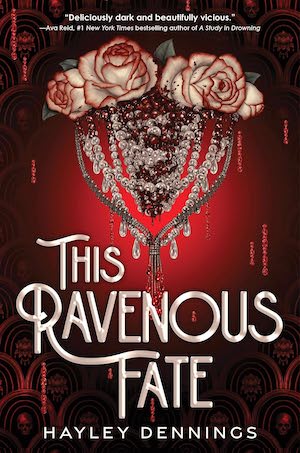Several years ago, best friends Elise Saint and Layla Quinn’s lives were turned upside down. Layla’s parents were murdered by reapers (this universe’s version of vampires) and Layla herself was turned, all while Elise’s father, a manufacturer of reaper-killing steel bullets, failed to intervene. Layla blamed Elise, and Elise in turn fled to Paris. Now, the Prohibition is still going strong, but in Harlem liquor and reapers are everywhere. Fresh from her time at a musical college in France, Elise returns to New York hoping to take her place as the heir to her father’s empire, sparing her younger sister the same fate. When Layla is framed for murder, the girls are once again pulled back together.
Elise only wants to protect her father’s business interests, while Layla is determined to clear her name. But something else is going on in the back alleys of Harlem. Reapers are going on rampages before turning human. Everyone is lying and the bodies are piling up. And something intense and passionate is sparking once more between these former friends.
Layla and Elise are troubled girls making trouble. All Elise wants is her father’s approval, especially after being away for so long. When Layla turned, Elise lost her best friend. When Elise betrayed her, Layla’s foundation was shattered. Both girls are unmoored and lost, drifting apart in a sea of anger and resentment. Each decides to use the other, to exact their petty grievances and to win the favor of the distant parental figure who looms over their lives. That means forming an alliance with each other while secretly using whatever information they gather to give themselves a leg up, whether in the reaper community or in the Saint steel empire. It’s hard to like either girl, but it’s equally as hard not to at least root for them. One cannot win without the other failing, but that didn’t stop me from cheering each victory and bemoaning each setback. Although friends-to-enemies-to-lovers is not one of my favorite tropes, Dennings handles the tempest between Elise and Layla well. She leans into the fraught romance, mercurial moods, and morally gray personalities.
Buy the Book


This Ravenous Fate
The novel struggles in a few ways. I’m not one of those people who needs a fully developed and detailed magic system in my fantasy, but I do at least need a basic understanding of how the world works. With This Ravenous Fate, I’m still unclear on the hows, whats, and whys of reaperhood or the alliances between the gangsters, the reapers, the humans, and the Saints. Dennings also repeats set-ups and action sequences without much plot development or character growth to distinguish them. This has the unintended side effect of turning compelling side characters into cannon fodder. It also bogs down Layla and Elise’s investigation. The “who” part of the “whodunit” is telegraphed early and often, but the girls are so distracted with side quests that it takes them a while to catch up to the reader.
Personally, I wish there was more sense of place. The setting, mid 1920s Harlem, is a thriving, fascinating place, but we see very little of it. Most of the events are centered on private residences and The Cotton Club. In both the real world and Dennings’ novel, it was a whites-only, mob-run club with mostly Black performers. While in its Harlem location, everyone from Duke Ellington to Cab Calloway to Dorothy Dandridge to Lena Horne performed there; women dancers were advertised as “tall, tan, and terrific,” meaning not older than 21 years old, at least 5’ 6” tall, and light enough to pass the paper bag test (the saying became famous enough that Bud Pollard directed a film with the same name starring the great Francine Everett about a singer and dancer at a nightclub who gets tangled up in a murder).
But the Cotton Club is only one of dozens of places for people to indulge in Harlem’s nightlife. Although Langston Hughes described the neighborhood as being plagued by a “growing influx of whites toward Harlem after sundown, flooding the little cabarets and bars where formerly only colored people laughed and sang,” it was also teeming with places for Black folks to spend time in. Alas, they barely get any mention. Diving deeper into what Harlem was like at this time would’ve opened up more opportunities to talk about colorism, segregation, queerness (even the Cotton Club hosted queer musicians like Ethel Waters and Bessie Smith), the First Great Migration (between about 1910-1940, about one million Black people left the South for more economic opportunities in the North, Midwest, and West with around 175,000 landing in Harlem prior to WWII), racism against identities other than Black, the Harlem Renaissance, the rapid rise of Black workers in industrial fields such as steel manufacturing, rent parties, etc. Perhaps it’s just the Black history nerd in me, but I had hoped this alternate history novel would play more in the historical sandbox.
Thing is, even taking into account the aspects that didn’t work for me, I still enjoyed This Ravenous Fate. Between the exciting premise and protagonists I wanted to hug as much as shake my fist at, it had me hooked. Layla and Elise are fun antihero protagonists. They make terrible decisions based on selfish reasons, then reap the bloody consequences. It’s violent, passionate, frenzied, and thrilling.
Readers, especially of the teen variety, who want to scratch that Interview with the Vampire tv show itch should look no further than Hayley Dennings’s This Ravenous Fate. It is the perfect late summer indulgence.
This Ravenous Fate is published by Sourcebooks Fire.

